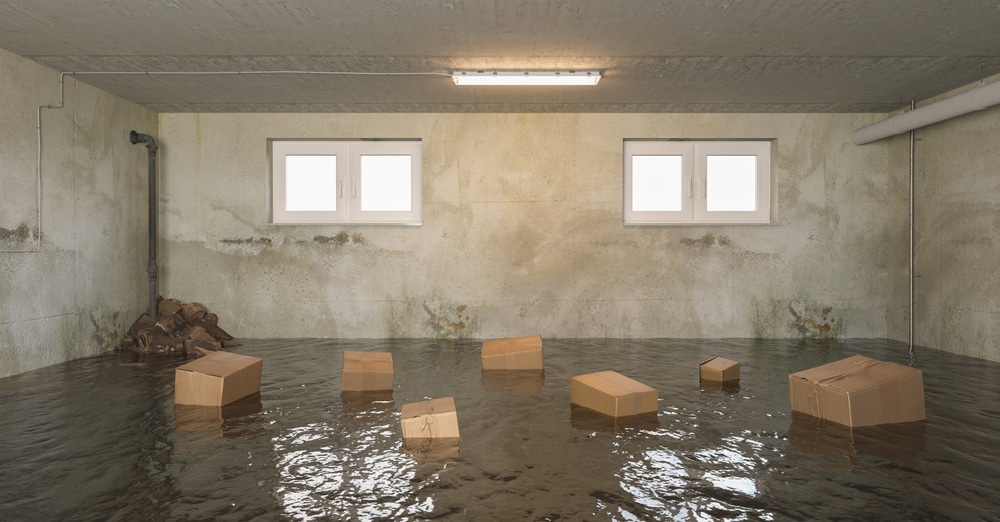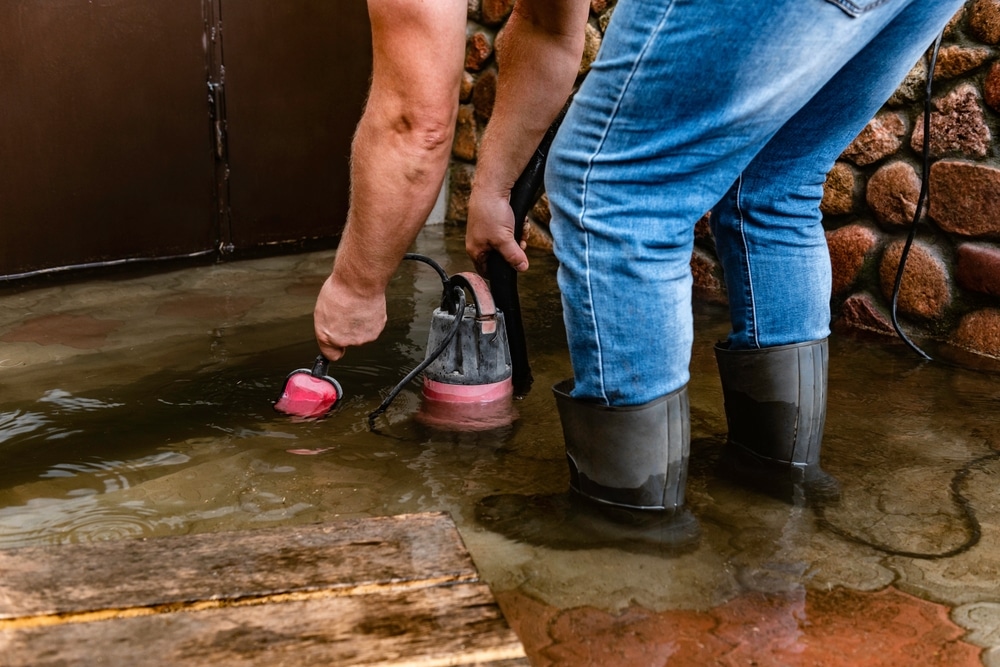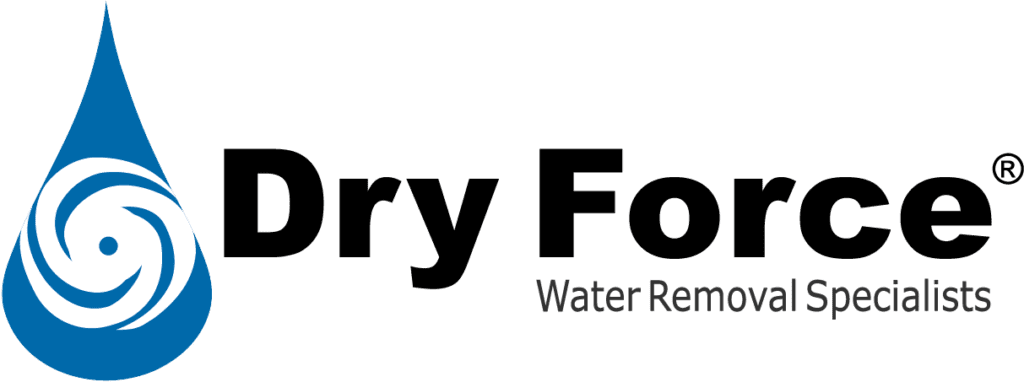
Flooding is a serious threat to the structural integrity of your home. When standing water infiltrates the area around your home, the garage is likely one of the first areas to be affected.
A flooded garage is undoubtedly inconvenient, but it can also lead to harmful mold growth, structural damage, and electrical hazards. That’s why quick action to remove water and properly dry out the area is crucial to protecting your home, wallet, and health.
The water removal experts at Dry Force offer expert solutions for you to salvage a flooded garage in this blog, including steps to remove, clean, and prevent further water damage.
Table of Contents
Assessing the Situation Before Cleanup
The moment you notice standing water in your garage, safety should be your top priority. Assessing the extent of the damage will help you take necessary precautions, protect yourself from potential hazards, and ensure you’re prepared to manage the cleanup effectively.
We recommend taking these steps after a garage flood:
- Assess the Extent of Damage: Identify items that can be salvaged and determine what may need to be replaced. Check for structural damage, waterlogged materials, and potential safety risks.
- Remain Cautious of Damaged Electrical Equipment: Water and electricity are a dangerous combination. If any electrical equipment, outlets, or appliances have been exposed to water, turn off the power to your garage immediately to prevent electrical hazards. If unsure, consult the professionals at Dry Force before proceeding.
Identifying the Source
Determining the cause of the flooding—whether from heavy rain, plumbing issues, or a leaky roof—is essential, as it will directly impact the cleanup process and any necessary repairs. By identifying the source of the flooding, you can take the right steps to address the issue efficiently and prevent further damage.
Understanding the Risks of Standing Water
Standing water in your garage isn’t just a hassle—it’s a hazard. It can create electrical risks, promote bacteria growth, and weaken your garage’s structure over time. Left unchecked, it may lead to mold, rot, and costly repairs. Acting quickly can help prevent these dangers and keep your space safe.
4 Steps To Remove Water From Your Garage
Once you have initially assessed the damage and potential source, it is time to begin swiftly removing the standing water from the garage. You can remove water from the affected area on your own—however, if you have any issues or foresee extensive safety concerns, you should call in the professionals at Dry Force for professional assistance.
Take these steps to carefully remove the standing water:
- Extract Water and Debris: First, contain and eliminate the standing water with a wet/dry vacuum or a pump. You’ll also need to remove any debris that entered the affected area during flooding to avoid further damage.
- Dry Out the Garage: Next, you’ll need to properly dry out your garage to prevent mold growth. You can achieve this by opening any windows and doors for ventilation and even fans and dehumidifiers to speed up drying.
- Clean and Disinfect: After water and debris hs been removed, make sure to clean and disinfect all surfaces to eliminate any contaminants to protect your health and possessions. The most effective way to clean and disinfect is by using a combination of common cleaning supplies, such as soapy water, bleach solution, white vinegar, disinfectant, etc.
- Evaluate Structural Damage: Since floods can weaken the structural integrity of your garage, inspect the walls and floors for any signs of structural damage. If you notice these signs, contact the professionals at Dry Force immediately.
Tools You Need for Water Extraction
Having the right tools is essential for effectively removing water from your garage. Here are the key items you’ll need:
- Submersible Pumps
- Wet/Dry Vacuums
- Mops and Squeegees
- Air Movers
- Dehumidifiers
- Water Claw Sub-Surface Flood Extractors
Using these tools will help speed up the cleanup process and prevent further damage.
Drying Out the Garage Efficiently
After removing standing water, it’s crucial to dry the flooded garage quickly to prevent mold growth and structural damage. Proper drying techniques will help eliminate excess moisture and restore your garage to a safe condition.
- Open Doors and Windows
- Use High-Speed Fans or Air Movers
- Run Dehumidifiers
- Check and Dry Walls
- Lift and Dry Flooring Materials
- Use Absorbent Towels or Mops
- Monitor Humidity Levels
How To Speed Up the Drying Process
A fast drying process is essential to prevent structural damage and cracking in a flooded garage. While household tools like fans can help, they may not be powerful enough to remove moisture quickly.
Commercial equipment, such as wet-dry vacuums and industrial air movers, provides a more effective solution for drying floors and surfaces efficiently. Professional water damage restoration services can also help prevent long-term structural issues.
Increased airflow and dehumidification are key to removing excess moisture and reducing the risk of warping, cracking, and weakening of floors, walls, and foundations.

Cleaning and Disinfecting the Garage
After removing standing water from your garage, it’s essential to thoroughly clean and disinfect all surfaces to prevent mold and mildew growth. This step is crucial for maintaining a healthy environment and protecting the structural integrity of your garage.
To start, you should mop the garage floors with warm water and generic soap. Then, disinfect using a chlorine bleach solution (1 cup of bleach per 1 gallon of water).
Best Cleaning Products for Water Damage
When selecting cleaning products, consider the severity of the water damage and your environmental preferences. Heavy-duty cleaners are suitable for extensive contamination, while eco-friendly options are effective for milder cases and are safer for the environment.
Heavy-Duty Options:
Chlorine Bleach Solution: Mix 1 cup of household bleach with 1 gallon of water to disinfect hard surfaces and eliminate potential mold growth. This solution is effective for sanitizing concrete floors and walls.
Eco-Friendly Options:
Mild Detergent Solution: Use a mixture of warm water and mild dish soap to clean affected surfaces. This option is less harsh on the environment, yet still effective for general cleaning of the area.
Preventing Future Garage Flooding
Now that you know how to address a flooded garage after it happens, how do you keep water out of your garage in the future? Implement the following strategies to minimize future flooding risks:
- Insert Weatherstripping Around the Garage Door: Regularly inspect and replace worn or damaged weatherstripping to ensure a tight seal against water intrusion.
- Monitor Foundation for Cracks and Damage: Seal small cracks with waterproof paint or a vinyl concrete patch; consult a professional for larger issues to prevent water seepage.
- Enhance Drainage Around Your Home: Install French drains and ensure proper yard grading to direct water away from your home’s foundation.
- Install Flood Vents: Allow water to flow through the garage during severe storms to equalize pressure and prevent structural damage.
- Place Flood Barriers or Sandbags: Place barriers or sandbags around entrances and vulnerable areas to block or divert floodwaters effectively.
- Place Electrical Components Higher: Elevate electrical outlets and circuit breakers at least one foot above potential flood levels to reduce electrical hazards.
- Seal the Garage Floor: Apply a waterproof sealant to the garage floor to prevent water from seeping through the concrete.
How To Improve Garage Drainage
Improving drainage in and around your garage is key to reducing flood risk. One effective solution is installing French drains along the driveway or in front of the garage to channel excess water away from your home’s foundation. Additionally, ensuring your yard is properly sloped will help direct runoff away from your house.
Routine maintenance is just as important—regularly cleaning gutters and downspouts prevents blockages that can cause water overflow and lead to flooding.

When To Call a Professional for Water Damage Restoration
When flooding catches you off guard, you may be able to remove the water and dry the space on your own. However, if you notice severe structural damage, persistent moisture, or signs of mold and mildew growth, that is when to call a professional for water damage restoration. Water damage can quickly escalate, leading to costly repairs if not addressed properly.
To protect your garage with quick action, contact the professionals at Dry Force for quick restoration services.
DIY vs. Professional Restoration: What’s Best?
Minor water issues, like small puddles or damp floors, are often manageable with household tools. However, more severe flooding, deep water saturation, or structural damage requires professional restoration to prevent long-term issues and costly repairs.
Hire Dry Force to Restore Your Flooded Garage
Don’t let garage flooding lead to costly damage—take action now. Hire Dry Force to restore your flooded garage quickly and efficiently!
